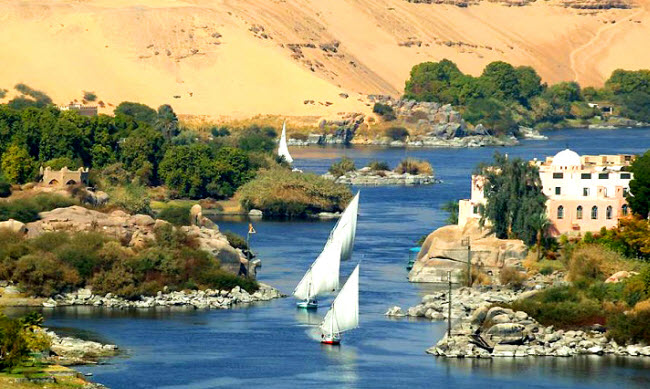The Nile River is one of the world’s greatest freshwater waterways, stretching 6,695 kilometers, making it the longest river on the planet. Flowing north from its remote sources in the Ethiopian Highlands and Central Africa to its sole outlet in the Mediterranean Sea, the Nile has played a crucial role not only as a natural resource but also as a significant cultural component throughout human history. Its fertile soil and irrigation capabilities have supported agriculture and the growth of civilizations in Egypt for thousands of years. Covering about 10% of Africa’s land area, the Nile Basin, like the Tigris and Euphrates in Mesopotamia, created a hospitable environment for one of history’s oldest and most influential civilizations, ancient Egypt. The river was integral to ancient Egyptian religion and cosmology, and most of its historical and cultural sites, aside from those near the coast, are located along its banks.
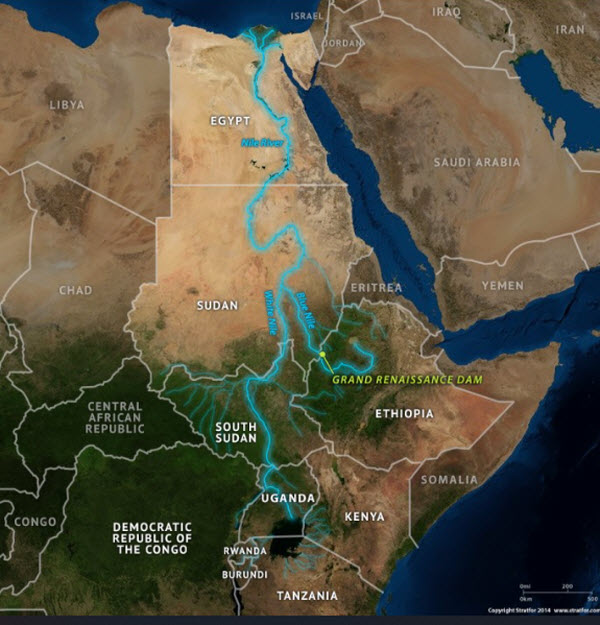
Geography of the Nile
The term “Nile” is derived from the Greek word “Neilos,” meaning “river valley.” In ancient Egyptian, it is called “Iteru,” meaning “the Great River.” The Nile has two primary tributaries: the Blue Nile, which is the main source of the river’s water and fertile soil, originates from Lake Tana in Ethiopia and flows into Sudan from the southeast. The second tributary, the White Nile, which is longer, begins in the Great Lakes region of Central Africa, with its farthest source in southern Rwanda. It flows north through Tanzania, Lake Victoria, Uganda, and South Sudan before joining the Blue Nile near Khartoum, Sudan. Both tributaries are situated on the western side of the East African Rift and the southern part of the Great Rift Valley. Another less significant tributary, the Atbara River, flows only during rainfall in Ethiopia but dries up quickly, meeting the Nile approximately halfway to the sea. The river then flows into Egypt, where it splits into two branches, the Rosetta and Damietta branches, which form the Nile Delta.
In the upper regions, the Nile flows through mountainous forests, but as it moves north, the vegetation changes to shrubs and shorter trees. In the desert, vegetation is sparse except along the river itself, where papyrus, used for making paper, boats, sandals, and ropes in ancient times, flourishes. The southern parts of the river are home to animals such as hippos and Nile crocodiles, as well as a variety of fish, particularly the Nile perch and tilapia, which are important food sources.
The White Nile
The source of the Nile is sometimes considered to be Lake Victoria in Tanzania. However, the lake itself has significant tributaries such as the Rukarara, Maji Maji, Nyabarongo, and Kagera Rivers. Water exits Lake Victoria through the Ripon Falls near Jinja in Uganda, forming the Victoria Nile, which flows about 500 kilometers through Lake Kyoga to Lake Albert. The waters then flow out of Lake Albert through the Albert Nile, entering Sudan where it is known as the Bahr al-Jabal (or “Mountain River”). Upon meeting the Bahr el-Ghazal, which is 720 kilometers long, it becomes known as the White Nile, named for the white silt suspended in its waters. The White Nile contributes approximately 31% of the Nile’s annual discharge but can contribute between 70% and 90% of the total flow during the dry season (January to June).
The Blue Nile
The Blue Nile originates from Lake Tana in the Ethiopian Highlands and flows 1,400 kilometers to Khartoum. Upon joining the White Nile, it forms the Nile River. Approximately 90% of the Nile’s water and 96% of its sediment come from Ethiopia. Erosion and sediment transport occur mainly during the Ethiopian rainy season in the summer, and occasionally when rainfall is particularly high throughout the year on the Ethiopian Plateau.
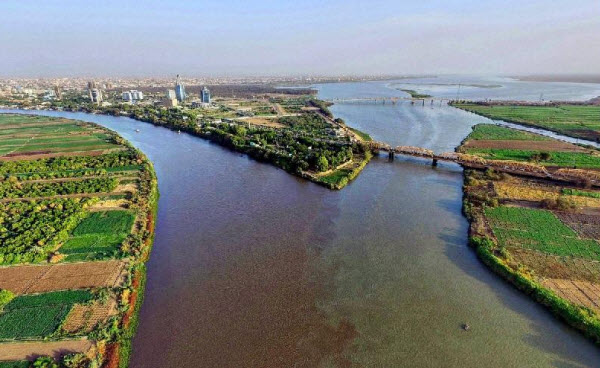
The Cataract and the Great Bend
Two major features define the Nile between Khartoum and Aswan: the cataract and the Great Bend. Since Roman times, cataracts have impeded boats from navigating between tropical Africa and Egypt, and the vast wetlands upstream from Khartoum made the river’s sources mysterious for thousands of years. The floodplains in this region were narrow or non-existent, limiting agricultural opportunities. These challenges in navigation and limited floodplains resulted in sparse population in this segment of the Nile.
The Great Bend is one of the Nile’s most prominent features. For most of its course, the river flows relentlessly north but turns southwest in the heart of the Sahara Desert, veering away from the Red Sea for 300 kilometers before resuming its northward journey. This deviation is attributed to tectonic uplift in the Nubian swell.
Flow of the Nile
South of the Great Bend in Sudan, the Nile has two hydraulic systems. The White Nile maintains a continuous flow year-round due to its storage in Lake Victoria and Lake Albert in Central Africa. As a result, the White Nile flows at a relatively constant rate throughout the year, keeping the Nile’s flow at Khartoum consistent during the winter months when the Blue Nile/Atbara system, which is affected by the Ethiopian rainfall and drought cycle, is dry. During the winter, little rain falls on the highlands, causing these rivers to dry up. In the summer, moisture-laden winds from the Indian Ocean, as they ascend the Ethiopian Highlands, lead to heavy rains that fill the valleys with flowing water that eventually joins the Blue Nile or Atbara. During the summer, the White Nile’s contribution is minimal, and the annual flood in Egypt is a gift from the Ethiopian monsoon.
After Aswan, water loss due to evaporation occurs as it flows slowly through the Sahara Desert. Water is also lost due to human use. Before the construction of dams, flows peaked in late August and early September, with the lowest levels occurring in late April and early May.
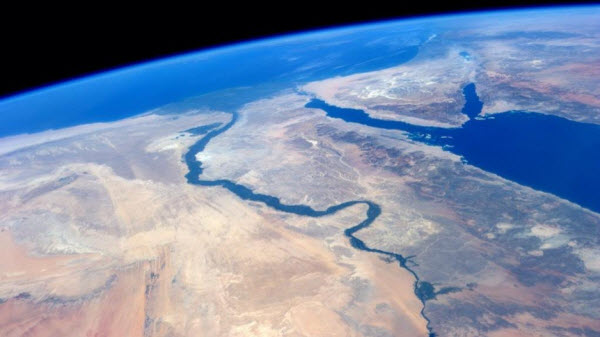
History of the Nile
The Nile has been a lifeline for Egyptian culture since prehistoric times. Due to climate change or possibly overgrazing, pastoral lands in Egypt dried up, leading to the formation of the Sahara Desert around 8000 BC. This forced the population to migrate to the river, where they developed a stable agricultural economy and a more centralized society. The Nile’s role was critical in establishing ancient Egyptian civilization, with the fertile lands surrounding it allowing Egyptians to grow wheat and other crops, providing food for both the population and trade. The Nile’s waters attracted game such as buffalo and camels, introduced by the Persians in the 7th century BC. These animals were used for food or domesticated for plowing, and camels were used for overland travel across the desert. The Nile itself was a convenient and efficient means of transporting people and goods.
The stability of the Egyptian state was directly related to the Nile’s fertility. Trade through the Nile fostered diplomatic relationships with other nations, contributing to its economic stability by providing the resources necessary for agriculture and trade, which funded a well-equipped and efficient military. The Nile played a significant role in politics, religion, and social life, with Egyptians believing that the Pharaoh controlled the river. In exchange for life-giving water and crops, farmers cultivated the fertile soil and sent part of their resources to the Pharaoh. The Nile was so integral to Egyptian life that they created a deity, Hapi, dedicated to the annual flooding of the Nile. The river was seen as a bridge between life and death, with the east symbolizing birth and growth, and the west representing death. Consequently, all tombs were placed west of the Nile, as Egyptians believed that to enter the afterlife, one needed to be buried on the side symbolizing death. The Greek historian Herodotus famously said, “Egypt is the gift of the Nile,” a statement reflecting the truth that without the Nile’s water for irrigation and agriculture, Egyptian civilization might have been short-lived. The Nile provided the necessary elements to create a vibrant civilization and contributed significantly to its sustainability for three thousand years.
Despite Greek and Roman attempts to explore the Nile’s sources, they failed to do so, and the river’s upper tributaries remained largely unknown. Various expeditions failed to determine the river’s source, and Europeans obtained only limited new information about the Nile’s origins until the 15th and 16th centuries, when travelers to Ethiopia not only visited Lake Tana but also explored the source of the Blue Nile in the mountains south of the lake. Although James Bruce claimed to be the first European to visit the Nile’s sources, contemporary knowledgeable scholars credit Portuguese explorer Pedro Páez. Meanwhile, the White Nile was less understood, with ancient peoples mistakenly believing the Niger River represented the upper reaches of the White Nile.
In modern times, Europeans first saw Lake Victoria in 1858 when British explorer John Hanning Speke reached its southern shore during his journey with Richard Francis Burton to explore Central Africa and locate the Great Lakes. Believing he had found the Nile’s source upon seeing this vast expanse of open water, Speke named the lake after Queen Victoria of the United Kingdom. Burton, who was recovering from illness and resting at Lake Tanganyika’s southern shore, was upset that Speke had claimed his discovery was the true source of the Nile, while Burton considered it still uncertain. This led to a major dispute, generating significant debate within the scientific community of the time and attracting other explorers eager to confirm or refute Speke’s discovery. British explorer David Livingstone failed to verify Speke’s discovery and instead ventured west into the Congo River. Ultimately, American explorer Henry Morton Stanley confirmed Speke’s findings by circumnavigating Lake Victoria and reporting the substantial flow at the Ripon Falls on the lake’s northern shore.
Today, South African Hendri Coetzee and his team were the first to navigate the entire length of the Nile, starting from Uganda through the White Nile in January 2004 and reaching the Mediterranean safely after four and a half months. In the same year, geologist Pasquale Sc
arcella confirmed the Nile’s total length of 6,695 kilometers, while others still debate whether the Amazon or Nile is the longest river. Scientific debates continue over the Nile’s exact length and sources.
The Nile’s Impact
The Nile has had an immense impact on the surrounding region, both in terms of human settlement and natural ecosystems. It has supported one of the world’s most ancient civilizations and continues to play a crucial role in modern Egypt’s economy. The river’s waters support agriculture, provide drinking water, and enable transportation and trade. However, the construction of dams, such as the Aswan High Dam, has altered the river’s flow and its seasonal flooding, affecting agriculture and natural habitats. The Nile also faces challenges from pollution, population growth, and climate change, which threaten its sustainability and the well-being of the millions who depend on it. Efforts to manage and preserve the river’s resources continue as nations work together to ensure that the Nile remains a vital source of life for future generations.
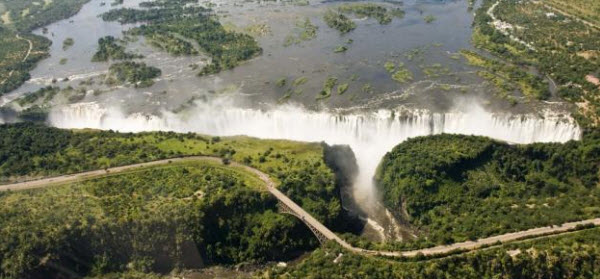
Tables and Statistics
| Feature | Detail |
|---|---|
| Length | 6,695 km |
| Source of White Nile | Lake Victoria, Uganda |
| Source of Blue Nile | Lake Tana, Ethiopia |
| Average Annual Discharge | 2,830 cubic meters per second |
| Major Tributaries | Blue Nile, White Nile, Atbara |
| Major Dams | Aswan High Dam, Sennar Dam |
| Significant Cities | Khartoum, Cairo, Juba |
| Key Lakes | Lake Victoria, Lake Albert, Lake Tana |
Trivia Points
- The Nile River was vital to the development of ancient Egyptian civilization.
- The Nile is often cited as the longest river in the world.
- The Blue Nile contributes about 59% of the Nile’s annual discharge.
- The White Nile is the primary source of the Nile’s flow during the dry season.
- The Nile’s annual flooding was a critical factor in Egyptian agriculture.
- The river’s annual flood historically deposited rich silt, enhancing soil fertility.
- The Nile is essential for the majority of Egypt’s population and agriculture.
- The Greek historian Herodotus referred to Egypt as “the gift of the Nile.”
- The river was crucial in the construction of the pyramids and other monumental structures.
- The Nile River has two primary tributaries: the Blue Nile and the White Nile.
- The river’s waters are used for irrigation, drinking, and industry.
- The Nile was historically a key trade route connecting various African regions.
- The river’s name is derived from the Greek word “Neilos,” meaning “river valley.”
- The ancient Egyptians worshipped Hapi, the god of the Nile.
- The Nile has been explored by numerous famous explorers, including James Bruce and Henry Morton Stanley.
- The Nile Delta is a large and fertile region crucial for Egypt’s agriculture.
- The Aswan High Dam, completed in 1970, controls the river’s flooding and generates hydroelectric power.
- The Nile River Basin covers approximately 10% of Africa’s land area.
- The river’s ecosystem supports diverse wildlife, including crocodiles and hippos.
- The Nile’s annual flood cycle is closely linked to the Ethiopian monsoon.
- The river is important for Egypt’s fishing industry.
- The Nile is the primary source of water for several other countries besides Egypt, including Sudan and Uganda.
- The river’s flow has been altered significantly by modern engineering projects.
- Ancient Egyptians believed the river was a divine gift from the gods.
- The Nile’s length has been the subject of scientific debate and measurement challenges.
- The river is a key feature in Egyptian art and literature.
- The Nile’s waters are also used for hydroelectric power in Sudan and Uganda.
- The Nile is vital for maintaining the ecological balance in the region.
- The river’s course and flow have been altered by natural geological processes.
- The river’s waters are a primary source of drinking water for millions of people.
- The Nile has inspired numerous works of art, literature, and music throughout history.
- The river’s floodplain supports diverse plant species, including papyrus.
- The Nile has been a focus of numerous archaeological studies and discoveries.
- The river’s waters support large-scale irrigation projects in Egypt.
- The Nile is crucial for the transportation of goods and people within the region.
- The river’s delta region is one of the most productive agricultural areas in the world.
- The Nile has been a source of both sustenance and conflict throughout history.
- The river’s flow is influenced by climatic conditions in the surrounding regions.
- The Nile’s waters are used for various industrial processes in Egypt.
- The river’s ecosystem is threatened by pollution and human activity.
- The Nile River has been a subject of international treaties and agreements.
- The river’s flow supports significant biodiversity, including many endemic species.
- The Nile has been the subject of extensive scientific research and exploration.
- The river’s waters have been crucial for the development of agriculture in ancient and modern Egypt.
- The Nile’s flow is monitored by various national and international organizations.
- The river’s delta is home to numerous bird species and other wildlife.
- The Nile has played a central role in the cultural and historical development of Egypt.
- The river’s waters are essential for maintaining the ecological balance in the region.
- The Nile’s flow has been affected by climate change and environmental degradation.
- The river’s waters have been the subject of numerous conservation efforts.
- The Nile’s waters are used for various recreational activities, including tourism.
- The river’s flow supports large-scale fishing operations in Egypt and Sudan.
- The Nile’s waters are crucial for the survival of many plant and animal species.
- The river’s ecosystem provides important resources for local communities.
- The Nile’s waters have been the focus of various international conservation programs.
- The river’s flow has been altered by the construction of dams and other engineering projects.
- The Nile has been the subject of various historical and literary works.
- The river’s waters are used for agriculture, drinking, and industry.
- The Nile’s ecosystem is home to numerous species of fish and other aquatic life.
- The river’s flow is influenced by seasonal rainfall patterns in the region.
- The Nile’s waters have been a source of inspiration for many artists and writers.
- The river’s delta region is a vital area for agriculture and food production.
- The Nile has been a central feature in the development of Egyptian civilization.
- The river’s waters support a range of economic activities, including agriculture and industry.
- The Nile’s ecosystem provides important habitat for many species of wildlife.
- The river’s flow has been the subject of various scientific studies and research projects.
- The Nile has been a key feature in the cultural and historical development of the region.
- The river’s waters are used for various purposes, including irrigation and hydroelectric power.
- The Nile’s ecosystem supports a diverse range of plant and animal species.
- The river’s flow is affected by climatic conditions and human activities.
- The Nile has been the focus of various conservation and management efforts.
- The river’s waters are essential for maintaining the ecological balance in the region.
- The Nile’s flow supports important agricultural and economic activities in Egypt and Sudan.
- The river’s ecosystem is home to a variety of plant and animal species.
- The Nile’s waters have been used for irrigation and agricultural development for thousands of years.
- The river’s flow is influenced by seasonal changes in rainfall and weather patterns.
- The Nile has been a source of inspiration for many cultural and artistic works.
- The river’s delta is a critical area for food production and agricultural activity.
- The Nile’s ecosystem provides important resources for local communities.
- The river’s waters are used for a range of purposes, including drinking, agriculture, and industry.
- The Nile’s flow has been altered by various human interventions, including dam construction.
- The river’s waters support a wide range of biodiversity and ecological processes.
- The Nile has been the subject of numerous scientific and historical studies.
- The river’s ecosystem provides habitat for many species of wildlife.
- The Nile’s flow is influenced by environmental factors such as rainfall and temperature.
- The river’s waters have been crucial for the development of agriculture and industry in the region.
- The Nile’s ecosystem supports a variety of plant and animal life.
- The river’s flow has been affected by changes in climate and human activities.
- The Nile has played a significant role in the cultural and historical development of Egypt.
- The river’s waters are used for various economic and recreational activities.
- The Nile’s ecosystem provides important resources for local populations.
- The river’s flow supports a range of agricultural and industrial activities.
- The Nile’s waters have been the focus of various conservation and management efforts.
- The river’s ecosystem is home to many species of fish and wildlife.
- The Nile’s flow is influenced by both natural and human factors.
- The river’s waters have been crucial for the development of civilization in the region.
- The Nile’s ecosystem supports diverse plant and animal life.
- The river’s flow has been the subject of ongoing scientific research and exploration.
- The Nile has been a key feature in the history and culture of Egypt and the surrounding region.
- The river’s waters are essential for maintaining the ecological and economic balance in the region.
